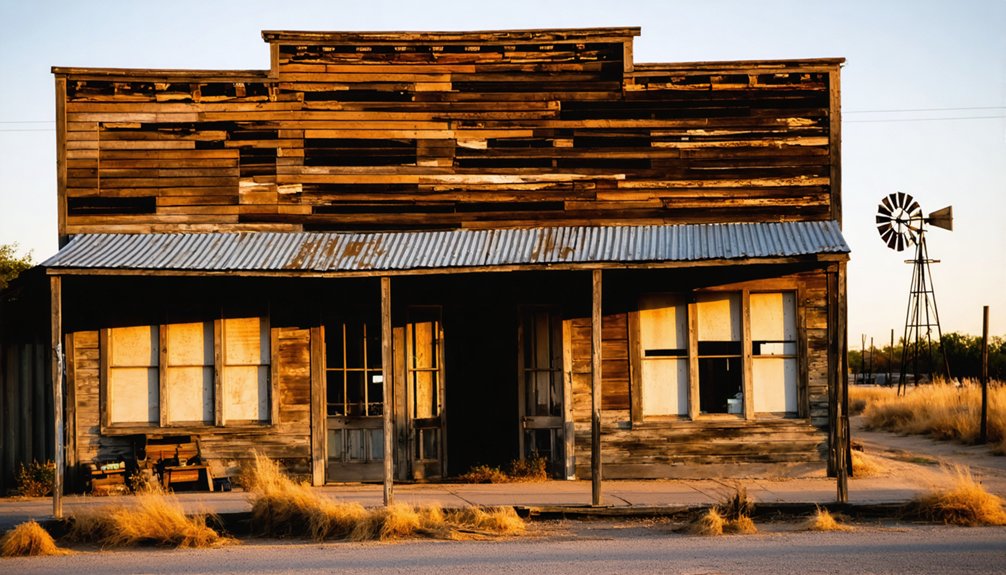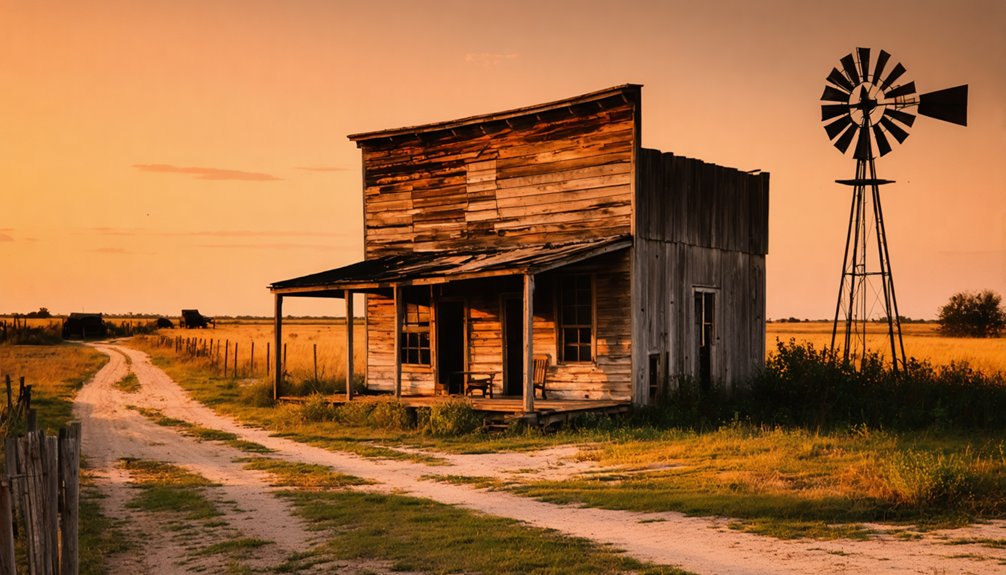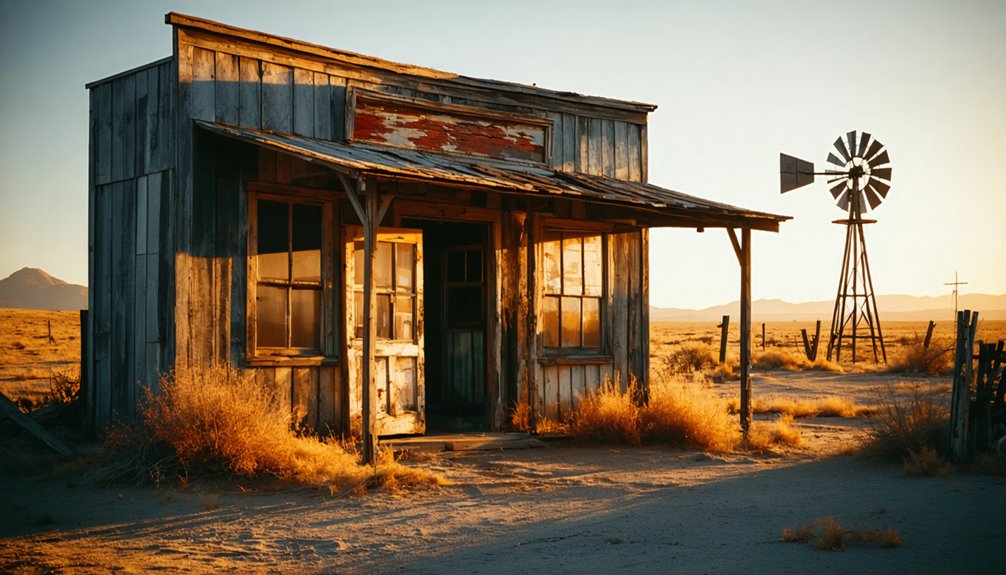You’ll find Knight, Texas near Big Sandy Creek, where it emerged as a ranching settlement in the mid-1800s. The community flourished around Charlie Knight’s store and post office established in 1889, with the Swedish Evangelical Lutheran Church serving as its spiritual center. While the town declined by the mid-20th century as younger residents moved to urban areas, you can still explore its wooden structures, old stone chimneys, and the 1923 Lutheran sanctuary that preserve Texas frontier life.
Key Takeaways
- Knight, Texas began as a ranching community in the mid-1800s, centered around Charlie Knight’s store and post office establishment in 1889.
- The town thrived on cattle operations and farming, with early settlers attracted by natural water resources and fertile terrain.
- Population decline began in the 1950s as younger generations moved to urban areas, leaving behind deteriorating structures and abandoned homesteads.
- Remnants include wooden buildings, stone chimneys, and the original post office site, providing glimpses into Texas frontier life.
- Preservation efforts face challenges including disputed property titles, infrastructure problems, and funding needs for maintaining historical structures.
A Ranch Becomes a Settlement
While Knight, Texas began as expansive ranch land, its evolution into a settlement marked the area’s first significant shift in land use. You’ll find the origins rooted in vast cattle operations that utilized the region’s natural water resources and fertile terrain, drawing early settlers who sought opportunities in ranching work.
These ranching transformations laid the groundwork for broader settlement growth, as large tracts of ranch holdings gradually gave way to smaller parcels. The Four-Section Act of 1895 encouraged more families to settle in the region.
You’ll discover that the area’s evolution accelerated when farming potential attracted families seeking agricultural prospects. The community took shape near established outposts like Menard’s Chapel, while dense forests and reliable water sources supported diverse farming activities. Local development grew significantly after Charlie Knight became postmaster in 1889.
The Lutheran Legacy
In 1876, you’ll find that the Lutheran community formalized its presence in Knight when 43 charter members founded the Swedish Evangelical Lutheran Church, which would later become New Sweden Lutheran Church.
As membership grew, the congregation expanded its original 1879 building in 1887 and ultimately constructed a new sanctuary in 1921-1923, complete with a distinctive 104-foot copper steeple that served as a spiritual landmark. Early worship services were conducted in homes and schoolhouses before the first permanent church building was completed. Following the pattern of other Swedish Lutheran congregations, the church joined the Augustana Synod in 1875.
You can trace how this church shaped the area’s development by functioning as both a religious center and cultural anchor for Swedish immigrants, preserving their traditions and customs within the Lutheran framework until the community’s eventual decline.
Church Founding and Growth
The New Sweden Lutheran Church established deep roots in Knight, Texas when forty-three charter members organized the congregation on February 23, 1876.
Initially named the Swedish Evangelical Lutheran Church of Manor, the congregation held services in homes, schoolhouses, and a small stone church at Gregg before completing their first dedicated building in 1879.
You’ll find evidence of the church’s rapid community growth through its physical expansion. In 1885, they built a parsonage that served both as the pastor’s residence and social kitchen.
By 1887, growing membership necessitated adding 22 feet to the church building. The congregation’s reach extended further in 1896 with a chapel in Manda Community.
Between 1921-1923, they constructed a new sanctuary featuring a distinctive 104-foot copper steeple, strategically placed between the original church and Manda chapel.
Like many other Lutheran churches in Texas, the congregation gradually transitioned to English worship services by the 1920s, influenced by World War I sentiments.
Similar to St. Petri congregation, they met in a Knights of Honor Lodge before constructing their permanent church building.
Religious Community’s Final Years
Despite the robust growth during its early years, Knight’s religious community faced significant changes as transportation networks and economic centers shifted away from rural areas in the mid-20th century.
The community first gained prominence when New Sweden Lutheran Church was established in 1876.
You’ll find the New Sweden Lutheran Church maintained its spiritual heritage through traditional liturgy and sacraments, even as community engagement declined.
While younger generations moved to urban areas, the church’s presence endured through:
- The 1923 sanctuary with its distinctive copper steeple serving as a visual anchor
- The Lutheran Cemetery preserving consecrated ground and family histories
- The relocated Manda chapel continuing Sunday School activities
The congregation’s dedication to Lutheran teachings and customs persisted, though with decreased attendance.
They aligned with larger Lutheran synods, contributing to Texas’s broader religious mosaic while maintaining their Swedish Evangelical roots.
Life on Knight’s Prairie
You’ll discover that Knight’s early ranching community thrived on the open prairie lands surrounding the dense Big Thicket forests.
Similar to the mining operations that once defined Shafter, Texas, ranching shaped the economic and social fabric of Knight’s early days.
The grasslands supported both domestic livestock and native wildlife, including white-tailed deer and small prairie mammals that grazed alongside cattle.
Local ranchers adapted to the seasonal patterns of the prairie, rotating their herds between different pastures to maintain healthy grazing grounds. Much like the safe river crossing that helped establish Plemons, Texas, Knight’s strategic location gave ranchers reliable access to essential resources.
Early Ranching Community Dynamics
Located near the convergence of Big Sandy and Menard Creek, Knight’s ranching community emerged as a reflection of late 19th-century Texas settlement patterns.
You’d find ranching practices deeply influenced by Spanish vaquero traditions, with cattle operations driving the local economy. Drawing from early Spanish missions, the area’s ranching development followed the pattern of land grant settlements. Community interactions centered around Charlie Knight’s store and post office, where ranchers and settlers would gather to exchange news and conduct business.
The daily rhythm of ranch life included:
- Cattle management operations drawing from vaquero handling techniques
- Strategic use of surrounding forest lands for grazing
- Regular gatherings at Knight’s store for trade and social connection
The community’s population of around 50 people maintained strong ties through shared ranching work and social activities, creating a close-knit network typical of Texas frontier settlements.
Prairie Wildlife and Grazing
While Knight’s Prairie teemed with diverse wildlife throughout its active years, the delicate ecosystem supported both native species and agricultural activities. You’d have found Burrowing Owls and raccoons as permanent residents, while Snow Geese made seasonal appearances.
The prairie’s ranching practices integrated wildlife conservation through managed grazing, which helped maintain ecosystem balance and biodiversity preservation.
Careful grazing management combined with native grass seeding and prescribed burns created habitat sustainability for endangered species like the Attwater’s Prairie Chicken and Texas prairie dawn flower.
Local agricultural practices supported essential plant-pollinator relationships, including harvester ants and miner bees. Through these thoughtful wildlife interactions, Knight’s Prairie demonstrated how prairie restoration could successfully merge ranching needs with native species protection.
Agricultural Foundations
Through strategic land patents and farming settlements, Knight’s agricultural foundations emerged in mid-1800s Texas as early settlers from Virginia, South Carolina, Alabama, Tennessee, and Missouri established their operations.
Settlement patterns centered around fertile lands and waterways, while crop diversification and agricultural practices adapted to the local Big Thicket ecosystem.
- You’d have found Richard Knight’s 320-acre land certificate, highlighting the era’s emphasis on substantial agricultural holdings.
- You’d have witnessed community cooperation through shared labor and tight-knit farming networks.
- You’d have seen a bustling mix of cotton fields, grain cultivation, and livestock operations supported by horse labor.
The tram railroad and strategic placement near Big Sandy Creek enabled farmers to transport their goods, while post offices in Knight and Mack facilitated essential communication for the growing agricultural community.
The Rise and Fall of a Rural Community

You’ll find Knight’s agricultural heritage preserved through the stories of its early farming families who worked the land around Big Sandy and Menard Creeks in the 1870s.
The New Sweden Lutheran Church, established in 1876, became the spiritual anchor that united these pioneering farmers and helped forge a resilient rural community.
While Knight’s population has dwindled since the 1950s, the legacy of its agricultural roots and pioneer spirit lives on through the preserved remnants of its farming past.
Agricultural Heritage Lives On
Although Knight’s physical structures have largely vanished, the agricultural legacy of this former Texas farming community lives on through its connection to the Big Thicket region.
The area’s sustainable agriculture practices, centered around Big Sandy and Menard Creek corridors, demonstrated remarkable community resilience during the early 20th century.
You’ll find this heritage preserved in the following ways:
- Dense forests and fertile creek lands that once supported local farmers now form part of protected conservation areas
- The intersection of agricultural and timber economies reflects the region’s historical approach to resource management
- Original farmlands near Knight showcase the shift from cultivation to environmental preservation within the Big Thicket National Preserve
Today, while Knight exists only in memory, its agricultural footprint remains etched in the landscape’s protected natural features.
Church Builds Pioneer Spirit
When pioneering families first settled in Knight, Texas, churches became the bedrock of their fledgling community‘s social and spiritual identity.
You’ll find that these sacred spaces served as more than just places of worship – they were crucial hubs where settlers forged bonds through community gatherings, resolved disputes, and maintained cultural traditions.
The church’s influence extended beyond religious services, fostering spiritual resilience among isolated frontier families facing harsh conditions.
You can trace how churches shaped Knight’s development, as they often determined the placement of essential services like post offices and influenced local naming conventions.
Even as Knight’s economic fortunes declined, the church remained a steadfast symbol of pioneer determination, hosting occasional services that kept community ties alive despite dwindling populations.
Remnants and Ruins Today
Despite decades of abandonment, Knight’s structural remnants paint a haunting portrait of Texas frontier life.
You’ll find ghostly encounters among deteriorating wood-framed buildings, where walls still stand chest-high and old stone chimneys mark former homesteads. Historical artifacts scatter the grounds, telling tales of pioneers through rusted tools and machinery parts.
Nature steadily reclaims the land, creating an eerie tableau:
- Mesquite and native grasses twist through crumbling foundations
- Wildlife inhabits the skeletal remains of former structures
- Weathered signage and railroad paths fade into the landscape
When you explore these ruins today, you’ll need to watch your step on dangerous terrain.
While some areas remain fenced off, dedicated preservationists maintain key structures and occasionally host guided tours, ensuring Knight’s story endures.
Stories From Former Residents

Through oral histories and preserved accounts, former residents of Knight paint a vivid picture of life in this small Polk County settlement.
You’ll hear tales of community nostalgia, as they describe hot summers and cool winters that shaped their daily routines. Their stories reveal a tight-knit group of 15-20 residents who shared rural traditions, from hunting to farming to helping neighbors in need.
Former residents often reflect on gathering at local landmarks, seasonal fairs, and church services that kept their community spirit alive.
Community bonds flourished through shared moments at landmarks, fairs and Sunday services, weaving together the fabric of small-town life.
They’ll tell you about the challenges of maneuvering 2WD roads and their reliance on neighboring towns for essential services.
While many eventually left seeking better opportunities, their memories preserve the values of resilience and self-reliance that defined their rural Texas lifestyle.
Preservation Challenges
Preserving Knight’s historical legacy faces numerous complex challenges that span legal, financial, and practical domains.
You’ll encounter legal obstacles ranging from disputed property titles to complex zoning restrictions, while infrastructure challenges demand substantial preservation funding for basic utilities and structural repairs.
Environmental risks and safety assessments must be carefully managed to protect both visitors and historical integrity.
- Crumbling wooden structures stand precariously against the Texas wind, their weathered boards holding countless untold stories.
- Overgrown pathways wind between abandoned buildings, where nature slowly reclaims its territory.
- Faded storefronts bear silent witness to the town’s former importance, their paint peeling beneath the scorching sun.
Community engagement remains essential, as local historical societies partner with private investors to overcome these obstacles.
Success depends on balancing authentic restoration techniques with modern safety standards while ensuring proper historical documentation for future generations.
Historical Impact on Texas Settlement

While seemingly modest in scale, Knight’s establishment and evolution exemplifies the dynamic patterns of rural Texas settlement during the late 19th century.
You’ll find that Knight’s story reflects broader trends in how communities formed around economic opportunities, particularly the timber economy that drove development in East Texas. The settlement’s growth around Charlie Knight’s store and post office in 1889 shows how commerce and communication services anchored rural populations.
The community dynamics you’d observe in Knight mirror those of countless Texas settlements: initial growth fueled by resource extraction, followed by agricultural development, and eventual decline as economic conditions shifted.
The town’s reliance on the Camden tram railroad and its strategic location near waterways demonstrates how transportation networks shaped the destiny of rural Texas communities.
Mapping Knight’s Heritage
Modern mapping of Knight’s heritage requires careful attention to both its geographic positioning and historical landmarks.
You’ll find this ghost town‘s cultural connections deeply embedded in the landscape, where environmental influences shaped early settlement patterns. The community’s location near Big Sandy Creek and Menard Creek highlights its ties to the Big Thicket National Preserve corridor.
- Original post office site and Menard Cemetery Road serve as key historical landmarks for mapping the town’s footprint
- Dense forests that attracted the tram railroad from Camden reveal the town’s economic foundations
- Remaining homes and directional signs to local cemeteries provide tangible reference points for heritage documentation
These elements create a thorough map of Knight’s past, preserving its place in Texas settlement history.
Frequently Asked Questions
Are There Any Documented Paranormal Activities or Ghost Stories From Knight?
You won’t find any documented ghost sightings or haunted locations in Knight – available research shows no specific paranormal activity reported there, unlike other well-known haunted Texas ghost towns.
What Happened to the Original Knight Family After Selling Their Ranch?
Like hitting CTRL+ALT+DELETE on their lives, you’d find the Knight family dispersed after the 1948 sale, pursuing diverse business interests while maintaining their ranching legacy through operations in Canada and other locations.
Did Knight Have a Post Office or General Store During Peak Years?
Yes, you’ll find that Knight had both a post office (established 1889) and a general store run by Charlie Knight, who served as the town’s first postmaster until the community’s decline.
Were There Any Notable Crimes or Wild West Incidents in Knight?
You won’t find documented outlaw encounters or frontier justice incidents in Knight’s historical records. Despite Texas’s Wild West reputation, there’s no evidence of notable crimes in this particular settlement.
What Native American Tribes Originally Inhabited the Knight Area Before Settlement?
Like shifting sands of time, you’ll find the area’s cultural heritage was shaped by the Comanche, Apache, and Kiowa tribes, with Tonkawa influences marking this tribal history’s untamed spirit.
References
- https://mix941kmxj.com/the-strange-sad-story-of-a-texas-ghost-town-youll-never-visit/
- https://www.youtube.com/watch?v=SaUCT73CKnY
- https://www.youtube.com/watch?v=phjUE19A8HM
- https://www.southernthing.com/ruins-in-texas-2640914879.html
- https://texashighways.com/travel-news/four-texas-ghost-towns/
- https://www.texasalmanac.com/places/knights-ranch
- https://www.lonestartreasure.com/texas-ghost-towns-and-their-buried-riches/
- https://en.wikipedia.org/wiki/List_of_ghost_towns_in_Texas
- https://www.ghosttowns.com/states/tx/knight.html
- https://www.tshaonline.org/handbook/entries/knight-tx



